Best Garden Hoses: Guide & Recommendations
We independently evaluate all recommended products and services. If you click on links we provide, we may receive compensation.
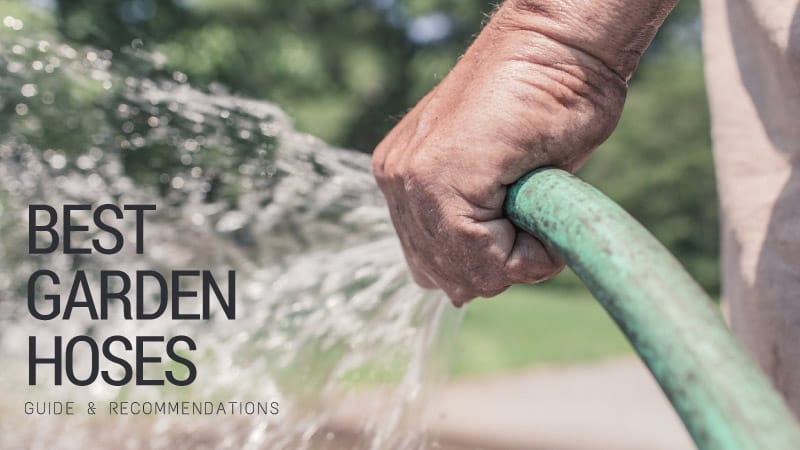
Updated August 21, 2018
With so many options to choose from and little visible difference between garden hoses, it’s tempting to simply choose the cheapest one. But small differences can have a big impact on how long the hose lasts and how easy it is to use.
A good garden hose should last 5 to 10 years. But many homeowners who buy lower quality hoses end up replacing theirs each year due to leaks, cracks or rot. Although some problems can be repaired, it’s generally more cost-effective to buy a good quality hose to begin with.
In this article, we review the features to consider when buying a new garden hose so that you’ll know what to look for in choosing a quality product.
If you’re just interested in the different types of hoses and our recommendations for the best garden hose, scroll down to Types of Hoses.
How to Choose the Best Garden Hose for You
There isn’t just one kind of garden hose that’s perfect for everyone. What works best for you will depend on the size of the area in which you’ll be using it, what you’ll use the hose for and where you’ll store it, as well as your budget. But, in general, there are six things you should consider when choosing a garden hose.
Important Considerations When Buying a Garden Hose
1. Length – Longer is Not Better
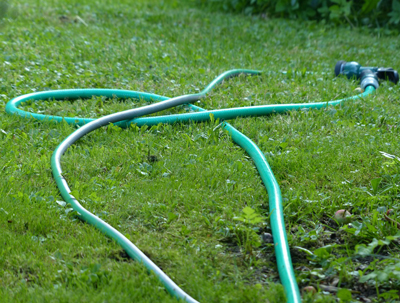
Only buy the length you need, no longer
Garden hoses come in 25-, 50-, 75- and 100-foot lengths. It’s tempting to buy one longer hose and use it for all of your watering needs around the garden. But don’t do it. Not only do longer hoses cost more, but they’re heavier to move around, need more storage space, can be difficult to drain before putting them away for the winter, and can result in lower water pressure coming out the end.
Measure the farthest distance from your spigot and buy a hose that goes just beyond that. You don’t want to tug on the hose to stretch it out as that’s likely to cause snags or leaks.
On a deck or balcony, a 25-foot garden hose is usually fine. Most urban yards need only a 50-foot hose, at most. If you need a longer length of hose than 50 feet, consider buying two hoses and joining them together when you need to go beyond 50 feet. That way you’re not lugging around a long, heavy garden hose all the time.
2. Hose Diameter – Width = Water Flow
The most common garden hose diameters are ¾ inch, five-eighths inch and half inch. These measurements are based on the inside diameter of the hose, not the outside. The bigger the diameter, the more water the hose will carry.
A hose width of five-eighths inch is generally most useful. It’s a good combination of water flow and pressure without being too heavy.
If hose weight is an issue for you, a half-inch hose may be best. They tend to be lighter weight but because of the smaller diameter they don’t carry as much water. Half-inch garden hoses are best kept to 50 feet or less and used for light-duty gardening tasks, such as watering containers and hanging baskets. These hoses are not appropriate for use with sprinklers or anything that requires higher water pressure (like washing your car).
3. Material – Rubber is Best
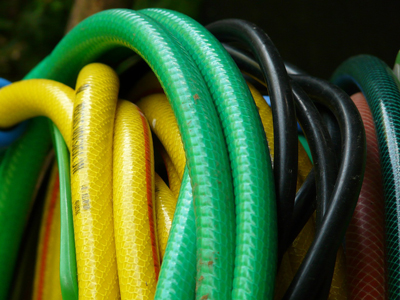
Garden hoses come in a range of colors and materials
You’ll commonly find garden hoses made of rubber, vinyl, or a combination of the two.
A basic vinyl hose (usually reinforced with a radial cord) is the least expensive and most lightweight option but also the least sturdy. It’s more prone to kinking, splitting and cracking than other materials and can degrade quickly if left in the sun or exposed to harsh weather. But if budget is an issue and you’ll only be using the hose for light duty gardening tasks, then a vinyl garden hose can be a good option.
Rubber hoses are generally the strongest and most long-lasting, but also carry the highest price tag and can be heavy to haul around the garden. Rubber has the added benefits of being able to carry hot water, being less likely to kink, and resisting cracking and ozone deterioration (so they don’t fall apart if left in the sun). For heavy duty use and a hose that lasts through many seasons, rubber is the best choice.
A middle-of-the-road option is a composite rubber/vinyl garden hose.
Reinforced hoses (usually reinforced with a mesh lining between layers of vinyl and/or rubber) are more resistant to kinking and splitting, and can take higher water pressure levels.
Although additional layers (or “plies”) tend to suggest a stronger hose, don’t put too much stock in this figure—the number of layers doesn’t matter as much as what those layers are made from. A strengthening “mesh” layer is a good sign, other things being equal.
Be careful with both rubber and vinyl garden hoses as they leach chemicals into the water than make it unsafe to drink. If you or your pets will be drinking from the hose, invest in a “drinking water safe” hose. These are generally made from polyurethane and have been specially built so as not to leach harmful chemicals.
4. Strength – Look at Burst Pressure
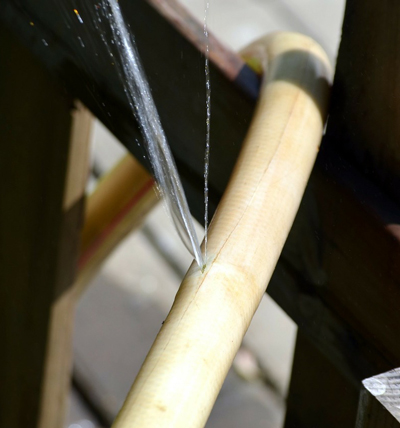
Some types of hoses are more prone to rupture than others. Be sure to buy one with the right burst pressure rating.
Garden hose strength can be measured in terms of “burst pressure” (the water pressure at which it is likely to rupture). If you’ll be using a hose nozzle or a sprinkler, look for a hose with a burst pressure above 350 psi. For pressure washer use, check your manual before buying a hose – you may need an even higher psi.
5. Flexibility – Try the Kink Test
You want a garden hose that’s flexible (for easy storage, going around corners, etc.) but not so flexible that it kinks easily. Kinking leads to splitting and shortens the life of your hose. While all garden hoses will kink if twisted (yes, even the “kink-free” hoses), some are better than others. In general, reinforced and rubber hoses are less likely to kink than other kinds.
When shopping for a garden hose, bend it into a U. If it kinks, pick another.
6. Couplings – Look For Cast Brass
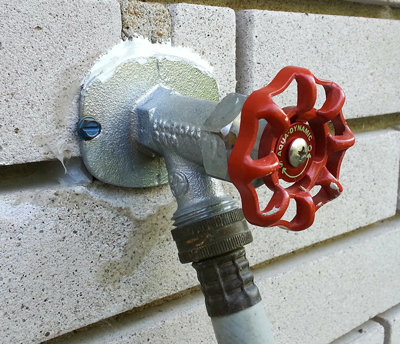
Stamped metal (like the coupling shown here) is usually not the best choice.
Garden hose couplings are the end pieces that attach to spigots, sprinklers and nozzles.
Less expensive hoses often have plastic couplings. Avoid these – they’re more prone to leaks, cracks and breakage and often can’t be tightened properly. Plastic also breaks down quickly, particularly when left in the sun.
Metal couplings (usually brass, although many are chrome plated) are either stamped or cast. You can identify cast brass because it’s thicker than sheet metal and usually has an octagonal shape so that the coupling can be turned with a wrench. Couplings made from cast brass are the most durable and leak-resistant. Thin stamped-metal fittings can be difficult to tighten at the spigot, bend easily (so don’t step on it or run over it with the lawnmower or car), and break down over time.
All else being equal, a large octagon-shaped coupling is easiest to tighten, particularly for those of us with stiff fingers or lower grip strength.
While many hoses come with a washer inserted into the coupling, these are often thin plastic washers that quickly break down. We always recommend that you use a high quality rubber washer (such as this one from Gilmour) at the connection point between the hose fitting and the spigot or nozzle. This will help prevent leaks.
Look for a collar. Quality hoses often have a plastic or rubber “collar” extending perhaps four to six inches up the hose from one coupling. This reduces the odds of a kink or split near the spigot, where they are particularly common.
Types of Garden Hoses
Below are descriptions of the most common types of garden hoses, along with our recommendations. Hover over each product name or image for pricing details.
Lightweight / Light Duty Hoses
These hoses are generally made from vinyl (sometimes with a reinforcing mesh or multiple plies (layers)) so can kink more easily, often have plastic fittings, and tend to come in thinner diameters but prices are in the lower range.
If you’re gardening on a budget, won’t be using it often, don’t need a long hose (over 50 feet), and have lower water pressure or don’t use a sprinkler or hose nozzle, then a lightweight hose will probably meet your needs.
While you can find light duty hoses online, your best bet is to visit your local home improvement store or garden center. You’ll find some of the heavier duty hoses there as well, but many of them are perfect for light duty use.
Regular and Heavy Duty Hoses
 Briggs and Stratton 8BS50 50-Foot Premium Heavy-Duty Rubber Garden Hose
Briggs and Stratton 8BS50 50-Foot Premium Heavy-Duty Rubber Garden Hose
>> Thick rubber with nickel-plated brass couplings. Stays flexible in very cold weather and can be used with hot water up to 200F. Made in the USA.
Scotts SMF58050CC MaxFlex Premium Heavy Duty Garden Hose, 5/8-Inch by 50-Feet, Green
>> Lead-free for safe drinking, with heavy-duty aluminum couplings, reinforcement at the spigot end, and a 500psi burst strength. Features ‘Lay-Flat technology’ to resist kinking.
 NeverKink 8844-50 Series 4000 Commercial Duty Pro Garden Hose, 5/8-Inch by 50-Feet
NeverKink 8844-50 Series 4000 Commercial Duty Pro Garden Hose, 5/8-Inch by 50-Feet
>>The company guarantees this hose not to kink. Has a coiled collar at the spigot end, lead-free aluminum couplings, and an anti-microbial to prevent build-up of mold and mildew. Stays flexible down to 45 degrees. Made in USA.
 Tuff-Guard The Perfect Garden Hose, Kink Proof Garden Hose, 5/8-Inch by 50 Feet
Tuff-Guard The Perfect Garden Hose, Kink Proof Garden Hose, 5/8-Inch by 50 Feet
>> This hose has a unique polypropylene double helix coil around the hose’s exterior to give it stability. It’s flexible but kink-free. 300 psi burst pressure. Machined brass couplings.
 Gilmour 10058050 8-ply Flexogen Hose, 5/8-Inch by 50 Feet
Gilmour 10058050 8-ply Flexogen Hose, 5/8-Inch by 50 Feet
>> With a lifetime replacement guarantee, this hose stays flexible at temperatures below freezing, has brass couplings and a collar, and a 500 psi burst strength rating.
Expandable Hoses

An expandable hose that hasn’t properly contracted after use.
You’ve probably seen ads on TV for these scrunchie-like hoses that expand up to three times their length when filled with water. They’re very lightweight (usually around 1 lb) and usually come in bright colors. Most are ½ inch in diameter and have adequate water flow comparable to a non-expandable garden hose of that diameter, but not what you’d get from a regular hose.
Although they do expand as advertised, over time expandable hoses tend to stop contracting properly, leaving you with a hose that’s difficult to coil or store. Be aware that when you open the nozzle after the hose is expanded it will shrink (sometimes dramatically) as the water pressure in the hose decreases.
And if you have high water pressure or leave the full hose in the sun, expandable hoses are prone to rupturing because of the thin (non-reinforced) and highly flexible inner tube.
Having said that, many people do like expandable hoses because of the light weight. They’re best stored out of the sun, treated gently (they usually have crack-prone plastic couplings, although some of the hoses listed below have brass couplings), and used for hand watering, rather than being hooked up to a sprinkler or soaker hose. And be prepared to replace your hose frequently…
We’ve tested a range of expandable hoses and there is only one we recommend at this time.
Drinking Water Safe Hoses
If you or your pets will be drinking from the hose or if you’re using it to fill a pool that will be used by children, make sure that your garden hose doesn’t leach harmful chemicals.
Most garden hoses are made with materials like plasticizers that give the hose flexibility but also contain chemicals, like BPA, lead, and phthalates, that find their way into the water in the hose. While these chemicals don’t harm your plants, they are toxic to humans.
Look for hoses labeled “drinking water safe” or at least “lead-free” – you’ll often find them sold for recreational use, such as for use in boats and RVs. These hoses are made with non-toxic, FDA-approved inner cores that don’t leach harmful chemicals.
And let water run through the hose until it’s cold before watering your vegetables or other edibles (chemicals leach from the hose and concentrate in the water as it heats up inside a hose that’s been left in the sun).
 Camco 22853 Premium Drinking Water Hose (5/8″ID x 50′)
Camco 22853 Premium Drinking Water Hose (5/8″ID x 50′)
>> 20 percent thicker than standard drinking water hoses and leaves no strong plastic taste in your drinking water. Machined nickel-plated brass fittings and strain-relief ends for added durability. Made in USA.
 Water Right PSH-050-MG-4PKRS Polyurethane Lead Safe Ultra-Light Slim Garden Hose, 50-Foot x 7/16-Inch, Olive Green
Water Right PSH-050-MG-4PKRS Polyurethane Lead Safe Ultra-Light Slim Garden Hose, 50-Foot x 7/16-Inch, Olive Green
>> Chrome-plated machined brass fittings with collars on both hose ends. 7/16-inch inside diameter handles 4-5 gallons per minute flow rate, although this is less than the typical 5/8″ hose. Comes in four colors. Made in USA.
 Plastair Marine/RV SpringHose PUWE625B9-M-3-AMZ 25-foot 3/8-inch Drinking Safe Water Hose, Blue
Plastair Marine/RV SpringHose PUWE625B9-M-3-AMZ 25-foot 3/8-inch Drinking Safe Water Hose, Blue
>> This lightweight hose is built primarily for marine use (with anti-salt water corrosive fittings) but works well for watering in small areas. Only stretches out to about 15 feet so buy a longer one if you need more reach.
Soaker Hoses
Soaker hoses are typically used for garden irrigation. These hoses are often made of recycled rubber and plastics and have porous walls. When the water is turned on, it oozes out through thousands of tiny holes in the hose, letting water seep out into or onto the surrounding soil.
Soaker hoses can either be laid directly on the ground (preferably below a layer of mulch), buried just under the surface, or even buried 6 or more inches deep (this is commonly done in large vegetable beds).
Soaker hoses come in a variety of diameters and lengths, from ¼-inch (these typically are part of a drip irrigation system and can be cut to length) to ¾-inch (these are the large black hoses you often see in garden centers). The larger hoses can be difficult to handle as they’re not very flexible. Use garden stakes to hold them in place and let them lie in the sun for a while to “soften up” before laying them in the garden.
Soaker hoses are best for relatively level sites and shorter lengths (although ¼ soaker hose can be effective for up to about 100 feet). If you’re using a large diameter soaker hose you’ll need decent water pressure to ensure that water seeps out along the entire length of the hose.
 Dramm 17010 ColorStorm Premium 50-Foot-by-5/8-Inch Soaker Garden Hose, Black
Dramm 17010 ColorStorm Premium 50-Foot-by-5/8-Inch Soaker Garden Hose, Black
>> Made from recycled material with nickel-plated brass fittings and extra thick walls to minimize spurting. Has a lifetime guarantee. >> READ OUR REVIEW!
 Miracle Gro MGSPA38050FM Premium Soaker Hose with Fittings, 3/8-Inch by 50-Feet
Miracle Gro MGSPA38050FM Premium Soaker Hose with Fittings, 3/8-Inch by 50-Feet
>> This hose has no attached couplings. Instead, you cut it to the desired length and insert the provided friction-fit, plastic male and female fittings. With two of each, you can even cut this into two separate hoses.
 MELNOR Flat Soaker Hose, 25-Feet
MELNOR Flat Soaker Hose, 25-Feet
>> This flat soaker hose is made from a woven/mesh material and has plastic couplings. It’s not a hose that you’d bury but it’s more flexible than a rubber soaker and works well with low water pressure.
 Apex 1030-100 Soil Soaking Hose, 100-Feet
Apex 1030-100 Soil Soaking Hose, 100-Feet
>> Unlike most soaker hoses, this one is made from vinyl for better flexibility. Available in a 25′, 50′, 75′ and 100′ lengths. Made in the USA.
 Snip-n-Drip Soaker Hose System
Snip-n-Drip Soaker Hose System
>> These 1/2-inch hoses are easily customizable to meet your irrigation needs – just cut pieces to length and connect. Includes 50′ of 1/2″ soaker hose, 25′ of 1/2″ garden hose, 1 faucet adapter, 1 quick-connect coupler, 8 hose couplers and an end cap. From Gardener’s Supply. >> READ OUR REVIEW
 Raindrip 015005T 1/4-Inch by 50-Feet Porous Soaker Tubing
Raindrip 015005T 1/4-Inch by 50-Feet Porous Soaker Tubing
>> This 1/4-inch porous tubing is typically used as part of a drip irrigation system. You’ll need to buy 1/4-inch barbed fittings and provide a 1/2-inch or larger water supply line, but it’s an efficient way to water and easy to set up.
Coiled Hoses
A coiled hose is formed into a tight spiral that pulls together when not in use and can be pulled out for use (some to an almost straight length of hose). They generally come in shorter lengths (15-foot and 25-foot lengths are most common, although some companies make longer ones) and a ½-inch or smaller diameter (resulting in lower water flow and pressure compared to a typical garden hose).
Because of the coils, these hoses tend not to stretch out to the full length. For example, a 25-foot hose may only extend 15 to 20 feet so take that into consideration when buying one.
And storage can be a little tricky; coiled hoses can’t be stored on a hose reel and will quickly tangle if placed in a large pot or storage bin. There are wall-mounted and stand-up hangers made for coiled hose storage but I’ve found that the coils get caught on the hanger.
Coiled hoses are best for hand watering and use in smaller areas, such as a patio or balcony, where the hose can be stored out of the way.
 Water Right PCH-050-MG-6PKRS Polyurethane Lead Safe Coil Garden Hose, 50-Foot x 3/8-Inch (Olive Green)
Water Right PCH-050-MG-6PKRS Polyurethane Lead Safe Coil Garden Hose, 50-Foot x 3/8-Inch (Olive Green)
>> Chrome-plated machined brass fittings with a collar and a 12-inch section of straight hose at both ends to make it easier to attach and use. Drinking water safe. Stretches just over 40 feet. Made in USA.
![]() Flexon PCH5850 Coil Hose, 50 feet (Green)
Flexon PCH5850 Coil Hose, 50 feet (Green)
>> Features a coil spring hose protector and solid brass compression couplings, plus a faucet adapter. 5/8-inch diameter at widest point (it’s somewhat oval shaped).
 Swan Self Coiling WRHC1200050 50-Foot Water Hose (Blue)
Swan Self Coiling WRHC1200050 50-Foot Water Hose (Blue)
>> A little thinner and softer than the other hoses but lightweight.
Flat Hoses
Flat garden hoses are similar to a fireman’s hose; they’re round when full of water but flatten down when empty. They’re generally lightweight, easy to roll up (they’re self-draining) and take less storage space than a conventional hose, but can be difficult to store without a hose reel.
Some flat hoses are sold with a hose reel but for ones that aren’t, check that they will fit with your existing reel (or the one you’re considering buying).
Because they’re very flexible (so that they can flatten out), flat garden hoses are generally made of vinyl, puncture and kink more easily and have a lower burst pressure rating. They also don’t work very well when pulled around corners. Plus, you have to unroll the entire hose before turning on the water.
Flat garden hoses are best used when storage space is an issue and the hose will be used in a straight line over a surface without many snags. In general, these are not the best choice for frequent use in the garden and there are none that we recommend for that purpose.
Video Resources
How to Repair the Damaged End of a Garden Hose
How to Fix a Ruptured, Punctured or Leaking Garden Hose
Now over to you – Which garden hoses have you used? What did you like? Not like? Let us know in the comments below!
Last update on 2024-04-27 / Affiliate links / Images from Amazon Product Advertising API
Enjoyed This Review?
If you liked this review, please sign up for our email updates with reviews, how-to articles and gardening videos!





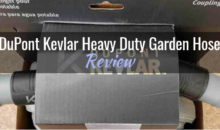

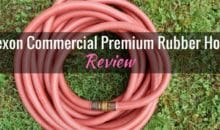
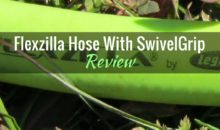
I have found the 75ft. Expandable Flexible Garden Water Hose to be the best. It diminishes to a manageable handful & is ounces instead of pounds. It survived the winter outside with no discernible problems & eliminates the need for worry that it will trash anything with which it comes in contact.
Was there a particular brand that you liked, Lisa?
Great comments as always. I appreciate you including vendors that supply the type of hose that you recommend. I read the article quickly, but I think I didn’t see a comment that the better hoses are harder to find, which means either ordering directly from the vendor or specialty websites. The better hoses will be found at high-end garden shops in larger, wealthier metropolitan areas.
You emphasized, but I recommend re-emphasizing, that the more a gardener pays the better the quality. The higher cost at first may feel unnecessary, but in the long run the investment is worth it.
I double your recommendation: buy a shorter hose! If you need length, buy multiple hoses. If I had a 200-foot run, I would buy eight 25-foot hoses. Two one-hundred-foot hoses are so heavy, they are almost impossible to lift.
Thank you for your input, Bill. It’s definitely true that you get what you pay for when it comes to garden hoses – it’s usually worth spending extra for a better quality hose. And those are typically not the hoses you’ll find in the big box stores…
Excellent research article and recommendations. Thank you.
You’re welcome 🙂
Thank you for your article. I have been waiting to purchase a new hose and did not know what to look for other than it no kinking. So much more to think about.
Good luck in your search, Gwen. I hope you found something you’re happy with. There are just so many options that sometimes it’s hard to keep things straight!
Hi Monica,
Thanks for a great article. I’m new to rooftop/balcony gardening and I’ve got a situation where I need to bring 50′ of hose from the south to the east side of the building. The rubber hose I bought says it’s good up to 190 degrees F – is that enough to make it through a hot summer on the south-facing roof surface?
thanks for any advice you can give.
Thanks for the kind words 🙂 190F? Yikes, that’s hot! If a rubber hose won’t last in that heat, nothing will. The one thing I’d strongly recommend is that you drain the hose after each use. Just turn off the water at the spigot and make sure the hose nozzle (assuming you’re using one) is open so any water in the hose can flow out. No need to do anything else. The point is to allow water to escape from the hose as it heats up in the sun. If you leave the hose nozzle closed, water in the hose will boil and can eventually rupture the hose. I use the Dramm ColorStorm hose (it’s rubber) here in Tucson where it’s currently 111F in the shade. I leave the hose lying on the ground. It handles the heat with no problem at all. You should be find on the rooftop with a good quality rubber hose.
I disagree with the statement that rubber is best. Maybe in some situations but from where I sit, the vinyl expandable hose is where it’s at! It’s lightweight, ounces instead of pounds, it coils up neatly, doesn’t kink & doesn’t get angry hot sitting out in the sun. Mine is 75ft and I can water my garden & even get to my back porch. When I turn off the spigot the water left inside is pushed out so the water doesn’t go to waste. There were several reviews of this item online saying it was cheap & broke. I’m not sure what turmoil these people were putting the hose thru but in my experience, the Expandable hose is a godsend.
Hi Lisa,
As with everything, what’s “best” tends to depend on your needs and situation. Rubber is generally best from a longevity, flexibility, and toughness standpoint – plus it withstands temperature fluctuations better than other materials. But if you’re looking for a lightweight hose, then rubber wouldn’t be a good choice. It sounds like you’ve found what’s “best” for you with your expandable hose 🙂 What brand is it? Sounds like one we should test out for a review.
Monica
Hi Lisa
Why do you think that when the expandable hoses break it must be because of user turmoil ? I bought two of these, which each lasted only 1.5 years with little turmoil applied by me – just regular weekly hosing and no stress. I managed to fix one (the internal hose snapped inside the skin for no apparent reason) but then it broke again 3 metres further down a month later. The second one (a different more expensive make) also only lasted about a year. I think they have a long way to go in materials development to get longevity with this design. The inside seems to perish with age just like a rubber band. Ive checked user comments on Amazon for other types of hose, and each one has roughly 10% of users hating that particular make / design. Seems modern day hoses are just not built to last, even the more expensive ones. ian
Many of the “new-fangled” hoses don’t seem to have the lifespan of “old fashioned” rubber hoses. For my money, a rubber hose is still the best bet if you’re looking something that will stand the test of time!
Hi Monica
Thank you for a well researched and well written review. As you review was written in April of this year and the FLEXZILLA garden hose range has been around for about two years now, I was wondering why you did not include it in the review? It is a very different hose, supposedly has tremendous flexibility in very cold conditions, is very light (comparatively) and has no memory (lays flat under all conditions). I’m sure you are aware of these hoses and would appreciate your views on them.
Many thanks
Eric
Hello Eric,
The Flexilla hose is currently under review and you should see that published in about a month. With so many hoses out there, it’s hard to include every one – and reviews take quite a while as we want to make sure that the product really does work over a prolonged period of time. So stay tuned!
Monica
Hi Eric, we just published our review of the Flexilla hose! You can find it here – https://gardeningproductsreview.com/flexzilla-hose-swivelgrip-hfzg550yws-review/
Hello Monica
Thank you for your informative reply. I look forward to the Flexilla review when its published in the near future.
Kind regards
Eric
Is there any more information, suggestions about soaker hoses?
Sorry, Bill. That’s all I have for now… There’ll be some detailed reviews on specific soaker hoses coming up soon.
Great evaluation. I am going to go get a Dramm right now.
Best hose article – thanks. I need to run a 75 ft hose that drains water from my off my roof, through a barrel,away from my house. At certain points it may need to be trenched a couple inches into the earth (not necessarily covered). I’d like to have that best RUBBER hose survive 5-10 years. Think it will work?
Hey Rick, I think it would work – but… any (rubber) hose, no matter how high quality, is going to degrade over time when left out in the elements. So will it last 5-10 years? Maybe, but I doubt it. You’d be better off running PVC pipe.
I was hoping for a review on sprinkler hoses, for use on long narrow strip of garden.
I formerly bought short (10 feet) soaker hoses to string around individual bushes, can no longer find them at the big box stores. I preferred fully assembled hoses as the do it your self varieties tended to blow apart (pressure too high?) Does any one still make them? I saw one on your list, buy 50 feet and receive two sets. Were extra fittings available?
If you’re trying to find short soaker hoses to place around individual bushes, then you may want to check out the Waterhoop (see the review here). They’ve upgraded it to prevent the kinking we found in our original review and we now highly recommend it. As for regular soaker hoses, extra fittings are generally available in the hardware store or directly from the manufacturer/distributor if bought online. And I believe that Dramm still makes a shorter soaker hose in a circle that’s intended for use with individual trees or shrubs – you’ll find those online or in independent garden centers.
I have purchased several types of hose over the decades and can confirm that the recommendations above are good ones. Rubber is best and I have 2 rubber hoses, one 50 ft and one 25 ft, which I join when necessary. Bought late 1980’s, My favorite choice as does not kink (much) and good flow. Moderately heavy in 5/8 in diameter, but the two lengths help, if weight is an issue.
I’ve tossed away several reinforced cheap vinyl hoses, not worth buying as they kink, can be easily damaged, and are stiff when cold. And the worst is a 5/8 dia composite hose, 100 ft long. It kinks EVERY time I use it, it is heavy, and very stiff when cold, hard to coil and drain at end of season.
So, if you are planning to need a hose for a long time (say more than 2-3 years, invest in a good quality rubber hose. Too bad my rubber hoses are finally starting to crack after 30 plus years!
No comments on the “specialty” and “novelty” hoses described -some may be suitable for their intended applications.
Thank you Paul! Rubber hoses really are the best in most situations.
Monica thank you SO much. Your input about the couplings was a great help to me.
So glad you found it helpful Jane! Thanks for letting me know 🙂
Thanks for the reviews.! I have been so frustrated trying to find nontoxic hoses and connectors for my garden. I bought soaker hoses a couple of years ago and now find they use recycled old tires, replete with lead and chemicals. So I guess my yard outside the garden is contaminated! Argghh!
Investing in all new hoses and connectors this year. So from your experience reviewing the soaker hoses, did I miss comments about lead-free, chemical free brands?
Thanks again!
Ugh, so sorry your yard isn’t as chemical-free as you’d hoped. I’m an organic gardener so I know how you feel. Unfortunately, I haven’t yet come across any soaker hoses that are confirmed to be lead-free/nontoxic. Some of the hoses with small holes may be (or you can make one yourself from one of the drinking water safe hoses) but true soaker hoses … I’m still looking.
I desperately need a hose that my French Bulldog can’t puncture. She is obsessed with “killing” the hose when I’m watering in the yard. Because I need several, the Armadillo hose is out of my budget. Any suggestions?
Dogs are so funny. Our neighbor’s chihuahua insists on attacking the “snake” every time he sees it. But a chihuahua can’t do as much damage to a hose as a French Bulldog! I think if she’s determine to “kill” the hose, eventually she’ll puncture pretty much anything. But it’s worth trying one of the heavy duty hoses, particularly the Dramm and Briggs & Stratton. They’ve pretty thick rubber so it may be more difficult for her to bite through – and they’re heavier so she may not find it as appealing to attack. The Stanley FatMax wouldn’t be a good choice. It’s tough for regular use but thinner so probably easier for her to chew on. Good luck!
My garden hose is in good shape except for some mold/mildew on the outside of it. I’m looking for suggestions re cleaning the hose without doing damage to the hose itself.
TIA
Is there any reels that will work with the new flex type hoses?
I gave away my heavy rubber hoses when my wife and I downsized to a low maintenance small bungalow style community with minimal storage space. I now need a lightweight easy to store in small space hose for watering the flowers and other light duty watering. I was about to buy the Pocket Flex Hose, but then read several reviews online about the low quality and leaking problems with them. Is there a lightweight hose brand, flex or otherwise, you would recommend for low usage. Have minimal space to store. Thanks, Mark
Hi Mark, There are a few hoses that are new to the market this year that I think would meet your needs (although we haven’t tested them yet), plus some of the 1/2 inch lightweight hoses, like those from Water Right. At the National Hardware Show last month we saw new hoses from Stanley (Aeroflex) and Swan that lay flat when not in use and expand when full of water. They don’t take up much space at all and are constructed differently than the typical expandable hose. I don’t think they’ve hit the market yet though. So, for now, if you’re able to store a short, 1/2-inch hose (perhaps on a wall-mounted hose reel) then I think that would be your best option.
I just purchased an expandable hose (Top brass 75′) and read a warning about lead on it’s label! Is this safe to use on my veg garden? We needed a new hose reel & this hose cost less than a reel, plus I got it at Rite Aid with “store money” that I earned with some coupon-ing deals so thought it was worth the risk. But not of potentially ingesting lead via my produce I could exchange for other hose they have — the Xhose. Haven’t found any online info about lead in that brand.
Thanks for any input
Watering veggies with a hose that has a lead warning (and many still do) is generally considered to be “safe.” But it’s wise to take some precautions, such as letting the water run for a while to flush out any water in the hose before using it on your edible plants – it’s the water that’s in the hose for a while, particularly if it’s been sitting out in the sun, that picks up lead and any other contaminants. You may also want to scrub or peel any veggies before eating them. As for the Xhose, I can’t tell you specifically about lead in that one.
Thanks so much for the feedback. I did that and it was the only time I used the hose. I found it to be quite heavy and the directions indicated it couldn’t be left outside. My back yard faucet is not near my garage. It is right outside my kitchen & I simply don’t have a place to keep it there.
Plus draining it & removing from faucet after EACH use is just a pain.
My front yard faucet wouldn’t be much more convenient but it’s very low water use. I only really water a couple of fruit trees, trickle for few hours a month. Expandable hose doesn’t work for that.
I need a hose for a rain barrel. Although barrel is on 3′ stand, flow is okay. Not concerned about water pressure. Don’t want lead (edible plants). REALLY don’t want kinking. Need 75′ for back yard; 100 for front (although, I could settle for 75′). With so many choices, sites, I don’t think I’ve ever been so confused. HELP!!!
Hi Belinda. If you want to be sure there’s no possibility of lead contamination, then you’ll need a hose that’s labeled as being “drinking water safe”. Many of those are only 1/2 inch diameter, although some of the newer ones are 5/8″. I don’t think you’re going to find one that’s 100′ long – that’s long for any hose! – so you’ll have to buy multiple shorter lengths and put them together. With a smaller diameter and lower water pressure (i.e., no pump), I suspect it’s going to be tough to get water through 100′ regardless of which hose you buy … As for kinking, I’ve yet to find a hose that never kinks – every hose has the potential to kink in specific circumstances (although some are more kink-prone than others). In any case, start with those hoses listed above in the Drinking Water Safe category and see if any meet your needs.
What is the best hose to be used with auto rewind hose reels… 100′?
Shorter is better – I’d recommend 50′ at most. A long length like 100′ is a LOT of weight to drag and is more likely to break the “auto rewind” feature.
Wow!
I can’t thank you well enough Monica. Well researched and excellent recommendations. Keep up the good work.
I was searching for perforated sprinkler hoses, (sprinkler, not soaker). I am needing to know the area covered “out” from a sprinkler hose. Nobody seems to know …
Hi Michael, that’s a good question. Unfortunately, the answer is “it depends” – mostly on your water pressure, hose length and how many holes there are in the sprinkler hose. Two people with exactly the same hose could find that the area watered by the hose is very different for each of them. For example, with high water pressure, a short length of hose and fewer perforations, the water would “spurt” farther than in a situation with low water pressure or a long hose or more perforations. It also depends on some extent to whether it’s a flat hose (which tends to spray water upward and so spreads out less) or a round hose (which sprays water in all directions). Having said that, as a general rule of thumb I wouldn’t expect a sprinkler hose to water more than 2 feet to either side of the hose.
Have you looked at the new stainless steel hoses?
Hi Mr. Ron! We’re in the process of reviewing two stainless steel hoses that we saw this year at the National Hardware show last month. The jury’s still out but you’ll see our full reviews this summer.
I’m surprised no one mentions the problems I’ve found with the aluminum couplings. I’ve fixed our hoses many times over the decades by replacing the couplings with replacement metal couplings bought from hardware stores. The big problem over the last handful of years is that the couplings are now almost all made out of aluminum instead of brass. They’re even disguised to LOOK like brass with a brass-colored anodizing. The major problem occurs when we’ve connected our hoses with aluminum couplers to a brass faucet and left it connected for at least 6 months – even years. Well, after that amount of time, there’s no way to unscrew the hose from the faucet! Those 2 metals form a major amount of galvanic corrosion that literally makes them impossible to get apart. Brass connected to brass will NEVER have a problem like this. I’ve had to cut the hoses off and then use a Dremel tool to cut 2 slits in the aluminum coupler on opposite sides while trying not to cut too deeply into the brass faucet threads. Then a screwdriver or small chisel with a hammer is able to get the 2 halves freed from the faucet. Then the faucet threads have to be cleaned up to get the traces of aluminum out before attaching anything else to it. A real mess you don’t ever want to have to deal with! I’m not sure if putting some kind of goop (such as petroleum jelly or anti-seize compound) on the threads would help when initially putting the hose on the faucet, but I don’t want to have to deal with that kind of mess! Also, the aluminum couplers corrode badly internally after being on a hose only a few years. One of ours had almost corroded completely through from the inside. That’s not good to have chunks of corrosion breaking off that flow down the hose and end up plugging up holes in sprinklers, etc. Again, brass will NEVER have a corrosion problem like this. We’ve had some hoses for over a decade, and the replacement couplers were in perfect condition when I salvaged and saved them from the hose before throwing the hose away. There is no way replacement aluminum couplers would last that long. From now on I’ll stick with real, solid brass connectors, thank you. I can’t believe hardware stores are still selling that aluminum junk with no warnings whatsoever to customers about this problem. I wish the hardware stores would stock real brass replacement couplers next to the aluminum ones now on the shelves and clearly mark what metal each is made of. Everyone needs to help spread the word. I’m surprised at how almost no one knows of this problem (even the employees of hardware stores).
Do you prefer the Dramm or the Briggs regular/heavy duty hose?
I personally prefer the Dramm heavy duty hoses because I love the colors! Plus, I’ve had one in use for 5 years, mostly lying directly in the sun (year-round, we live in Tucson) and it’s still going strong. But if you don’t want a brightly colored hose, then the Briggs is a great choice.
Is it worth buying the more expensive contractor hoses or sticking with the middle of the road stuff? Also, which diameter of hose is best for watering the lawn/sprinklers?
For watering the lawn, use a standard 5/8″ hose. Smaller diameter hoses don’t generally have enough pressure to make a sprinkler work well.
As for contractor vs mid-range, that all depends on you. I prefer to go for contractor grade hoses that last a long time (with proper care), rather than replacing hoses every year or two.
I have had a 75 foot rubber hose for as long as I can remember – it has served me well! A few days ago the end of the hose flew off. Does anyone repair these(or is the strength of permanently compromised)? Do I call it a day and simply buy a new one? Thoughts and advice?
There are fittings you can buy (probably at your local garden center or hardware store) that are used to repair the end of the hose. But sure to buy a solid brass one with a metal clamp to keep it firmly in place. And cut a few inches off the end of the hose before installing the fitting so it will fit snugly. Good luck!
I have a black rubber Goodyear garden hose that I’ve been pretty happy with. It has held up very well with the exception of the black color starting to rub off on my hands during watering. I haven’t been able to find anything online indicating how this could be fixed, short of replacing it. I was wondering if anyone has heard of coating it perhaps with an automotive product that they sell to use on tires or plastic-silicone based. Any ideas?
Hi Toire,
I think what’s happening here is that your rubber hose is starting to degraded from the sun’s harmful UV rays. I haven’t heard of anyone coating a hose with a UV protectant. But from experience I can tell you that I changed a tire on my RV that had a UV protectant on it (that stuff that makes the tire look new and nice and shiny). The moment I touched the tire to change it my hands were coated with a black rubber-like material. I had to wash my hands with some major soap to get the oily-like dirt/black rubber color off my hands. Automotive or marine UV protectant may work differently on a rubber hose than a rubber tire. If it were me, I’d buy some of the UV protectant and give it a try on a section of your hose, maybe in the middle so that if it doesn’t work you don’t have to touch it much. A bottle of UV protectant is less expensive than a new rubber hose … so nothing ventured nothing gained. If it doesn’t work, you could use the stuff on your car. Let me know how you make out.
Excellent researched and recommendations. Keep up the good work Monica. Thank you.
Excellent research and recommendations. Cannot do any better. Thanks Mate!
I’m looking for a portable hose reel that opens after coiling hoses for winter storage. Does anyone make them?
Hi Joyce, I’m not quite sure what you’re looking for. Can you tell me a little more about what you mean by “a portable hose reel that opens”?
Wow, I feel after reading this I’ve hit upon ‘Garden Hoses:101′ Such a wealth of info, thank you.
However, I do have an actually question I’m hoping you can assist me with- I have a very large yard (approximately 3500+ sq ft). No sprinkler system because of layout so needs watering by hose. The problem is I have a spouse that absolutely loves cactus and all living plants sharp and pointy! Well this is fine (not really) except for what it does to our hose. It’s as if I’m constantly watering with a 100’ soaker hose, at least I am always soaked after using it.
Hoping you can advise to a puncture-proof or at least puncture-resistant hose of good quality. Please and thank you.
Living in the desert with lots of spiny cactus around, I know how you feel! The best hoses I’ve found in this situation are the heavy duty rubber hoses (my Dramm hose has gone 5+ years without any punctures). Another option is the newer lightweight hoses with a tough outer fabric shell (such as the Stanley ExoJacket hose – there’s even one with Kevlar in the fabric). Please note that we haven’t specifically tested those types of hoses against cactus!! They performed well in our field testing and I expect they’d stand up to at least occasional contact with a cactus or other thorny shrub, but I can’t say that for sure.
I just recently purchased a lightweight 50ft expandable hose from amazon and I love it. We don’t live anywhere near the desert, so I could not really say if it would be good for desert living but it works great for us. I think it was from home life pros brand.
What an excellent and thorough article! Thank you so much for all this research! I hope you can help me understand the burst pressure a little better. According to google, the highest psi for a water tap is 70. So why do we need a hose with 350 psi burst pressure rating with a sprinkler? Does the sprinkler increase the psi within the hose?
Hi Monica, I’ve got a bit of a strange one. Would you know of a product that woul enable me to connect a garden size hose to an lay flat hose? Kind regards
Kami